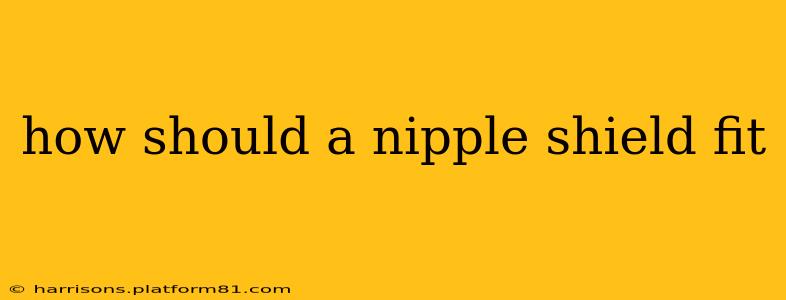Breastfeeding can be a challenging journey, and sometimes, using a nipple shield can make all the difference. But getting the fit right is crucial for both comfort and effectiveness. A poorly fitting nipple shield can lead to discomfort for you and your baby, potentially hindering successful breastfeeding. This guide will provide a comprehensive understanding of proper nipple shield fit and address common concerns.
What is a Nipple Shield?
A nipple shield is a thin, flexible disc with a hole in the center, made from materials like silicone. It's placed over the nipple and areola during breastfeeding, allowing the baby to latch onto the shield instead of directly onto the breast. They're often used temporarily to address latch difficulties, flat or inverted nipples, or sore nipples.
How Should a Nipple Shield Feel?
A properly fitted nipple shield should feel comfortable for both you and your baby. Here's what to look for:
- For Mom: It shouldn't pinch or constrict your nipple or areola. There shouldn't be any significant discomfort or pain during or after feeding. The edges should lie comfortably against your skin without digging in.
- For Baby: Your baby should be able to latch easily onto the shield without struggling. Observe their feeding; they should be able to rhythmically suck and swallow, without signs of frustration or difficulty.
Should You Be Able to See Your Nipple Through the Shield?
This is a crucial aspect of proper fit. Yes, you should be able to see a small amount of your areola surrounding the nipple hole. If the shield is too small, your nipple will be compressed, potentially causing pain. If it's too large, the seal will be compromised, impacting the baby's ability to latch effectively and potentially leading to poor milk transfer.
How Much of the Areola Should Be Covered by the Shield?
Ideally, only a small portion of your areola should be visible around the nipple. The majority of the areola should be covered. The goal isn't to completely obscure the areola, but to ensure a good seal and prevent the shield from interfering with the baby's latch.
What if the Nipple Shield Feels Too Tight or Too Loose?
- Too Tight: If the shield feels too tight, it could be the wrong size. Try a larger size. Remember, a snug, yet not constricting, fit is ideal.
- Too Loose: If the shield is too loose, it won't create a proper seal, and your baby may struggle to latch effectively. In this case, try a smaller size. Consider consulting a lactation consultant for additional guidance.
Can I Use Different Sizes of Nipple Shields?
Yes, nipple shields come in different sizes, and choosing the right one is important. You may need to experiment with different sizes to find the best fit. Often, starting with the size recommended by the manufacturer is a good starting point, but individual needs may vary.
What Should I Do if My Baby Is Having Trouble Latching with a Nipple Shield?
If your baby seems to be struggling to latch with the nipple shield, even with a proper fit, consult a lactation consultant. They can assess both your and your baby’s situation, offering tailored advice and addressing any underlying latch issues. They can also help you determine if the nipple shield is truly necessary, or if there are other strategies that could better support successful breastfeeding.
How Often Should I Replace My Nipple Shield?
Hygiene is crucial when using nipple shields. Replace your nipple shield regularly, typically after a few uses, or more often if it shows signs of wear or tear. Proper cleaning and sterilization between uses is also essential.
Using a nipple shield effectively involves understanding the nuances of proper fit and attending to your individual needs. If you have any doubts or concerns, always seek professional guidance from a lactation consultant or healthcare provider. They can help ensure a safe and successful breastfeeding journey for you and your baby.
